Gallery
Demolishing Houses and Restoring Lives
While helping with hurricane relief work, Cru® intern Lauren Light discovers unexpected spiritual needs in a small town still fighting to rebuild.
May 2018
A young man steps onto the soft grass of a courtyard. A nearby 10-story, four-sided mosaic bursts with color.
Depicting the history of Mexico, the mosaic mural wraps around the central library of Universidad Nacional Autónoma de México. The library’s floors, shelves and books buzzed all morning with activity, exhausting young minds at UNAM.
The young man, Josue Gallardo Sandoval—or “Josh” to his friends—feels the fatigue of the busyness around him.
It’s time for a siesta.
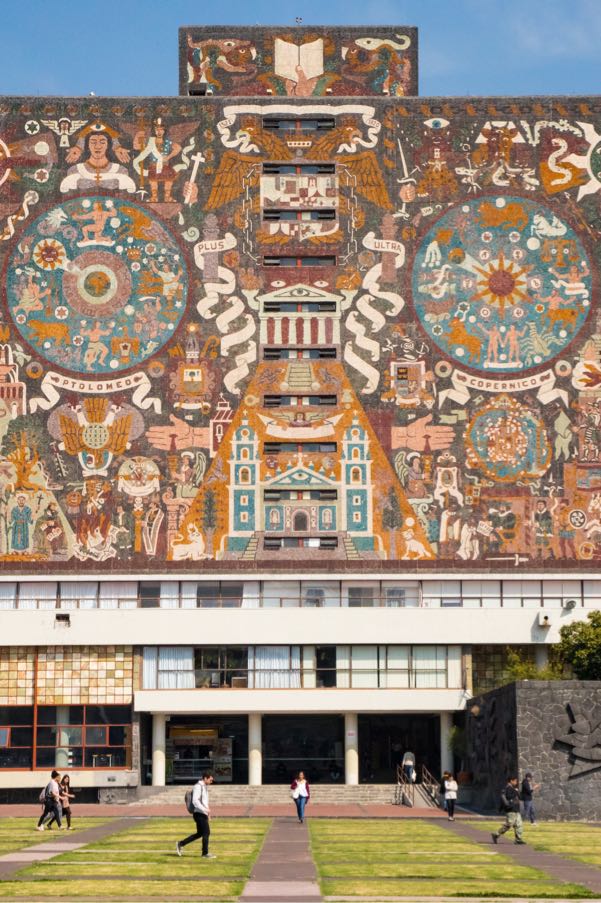
A mosaic mural depicting Mexico’s history wraps around Biblioteca Central, Universidad Nacional Autónoma de México’s Central Library, covering approximately 43,000 feet.
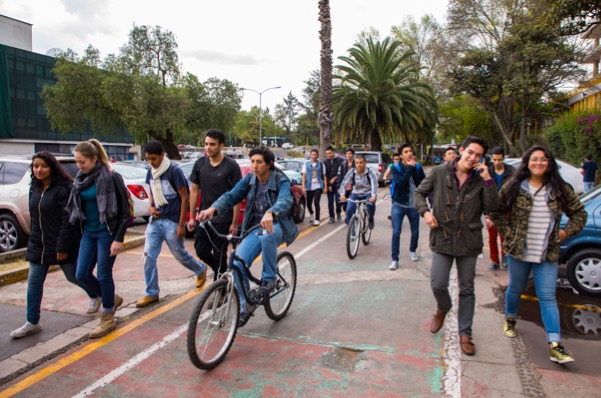
University students bustle across UNAM’s campus. More than 300,000 students attend this public university, making it one of the largest in the world.
Next to the grass, Josh finds a concrete ledge and stretches out. He hears bikes clicking, birds chirping and students laughing. His breath slows and his eyes close, embraced in the arms of blessed sleep.
Three figures approach, their mischievous grins revealing their intentions. One crouches below Josh’s perch, barely containing his giggles as he stretches his arms out beneath Josh. The second, a Korean man, approaches stealthily, filming.
The third sneaks up with his arms outstretched. He shoves Josh, shocking him awake. Josh scrambles to stay on his shelf. As his fear subsides, Josh begrudgingly gives in to laughter with his friends.
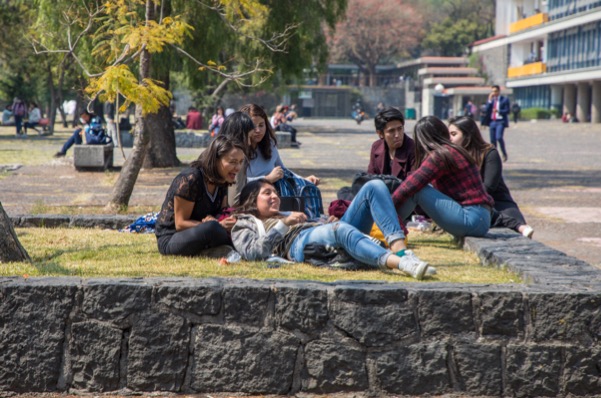
Students find time between classes to catch up on work, check social media or take a siesta in one of UNAM’s many campus parks. These parks offer natural meeting locations for Cru®.
But they’re more than friends; they’re family. And the one responsible for this close bond is the one filming, Sung Jae Lee.
In 2013, Jae, as his friends call him, visited Mexico with a group of Korean students for a short-term mission and recognized the need for full-time work.
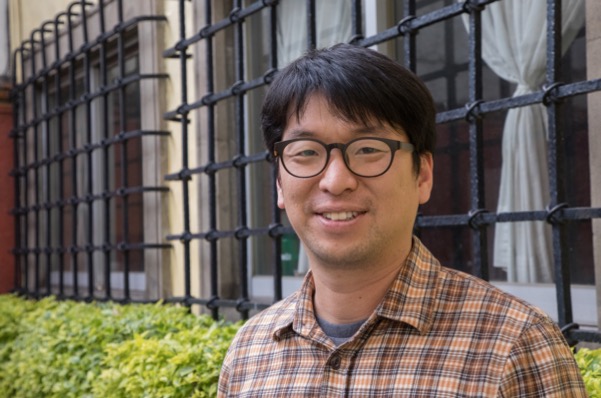
Jae stands in front of the home where the four Cru® UNAM groups meet once a month. The building also serves as a home for Korean interns spending a year abroad to serve with the Mexico City team.
At the request of Cru® in Latin America, Jae, his wife, Hanna, and their 1-year-old son moved to Mexico City a year later to revive the Cru ministry on UNAM’s campus. They didn’t know a lick of Spanish and needed to find a home. But because of miscommunication within the ministry at the time, no one helped them settle in.
So, armed with one Spanish phrase, “Do you have a room for rent?,” they set out and began knocking on doors. When many people met their question with a torrent of Spanish, the Lees responded, “No hablo español. Do you have a room to rent? Yes or no?”
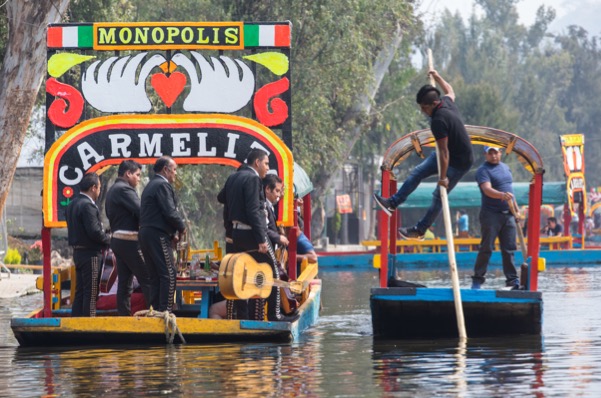
Canals that predate the Aztecs wind around beautiful islands in Mexico City’s borough of Xochimilco, which translates to “where the flowers grow.” The canals total about 66 miles in length—a remnant of waterways that connected the lakes in the Valley of Mexico.
Though they eventually found a place and enrolled in Spanish classes, Jae and Hanna felt sidelined and alone. Why had they flown halfway around the world for this?
But they didn’t want to give up. If, after a year of learning Spanish, they wanted to rebuild a student ministry at UNAM, they figured the task was up to them alone.
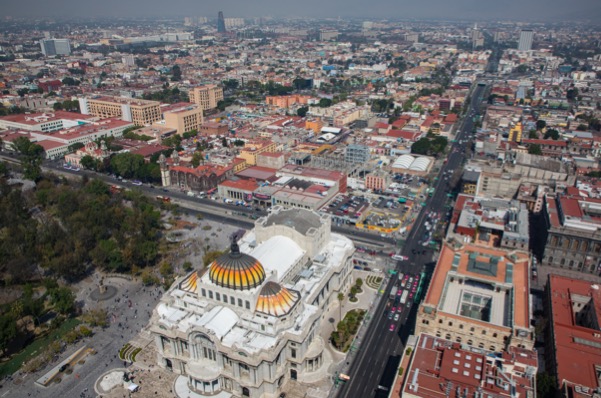
Mexico City’s Palace of Fine Arts, viewed here from atop the Torre de Latinoamericana near the city’s main square, hosts musical, dance and visual art events.
After that first year, Korea Campus Crusade for Christ sent a team of college students to join Jae and Hanna. Hanna, pregnant with their second child, hoped her son would come on his due date, after the team left.
But as the team boarded the plane for their 13-hour flight to Mexico, Hanna’s water broke. In their small flat, Jae scrambled. He didn’t have anyone to call. The hospital wouldn’t permit Jae to bring now 2-year-old Sam with them. It was 2 a.m., and Sam was fast asleep. Jae thought, I’ll take Hanna to the hospital, stay for her surgery and rush back.
But Hanna’s labor took longer than expected. At 5:30 a.m., Jae snapped a picture of newborn Nathan and frantically raced home. Opening the door, he heard crying.
Oh no.
Terrified, Sam had barricaded himself in his play tent in the family room. But seeing Dad, he sprinted to him. They collided, knelt and wept, arms wrapped tightly around each other.
Just as Sam felt Jae’s absence, Jae and Hanna had felt that God was absent.
But in that moment, Jae realized that God had remained with them the whole year.
The incident gave Jae a renewed heart. With a fresh perspective and the help of the Korean summer mission team, Jae set out to launch a campus ministry.
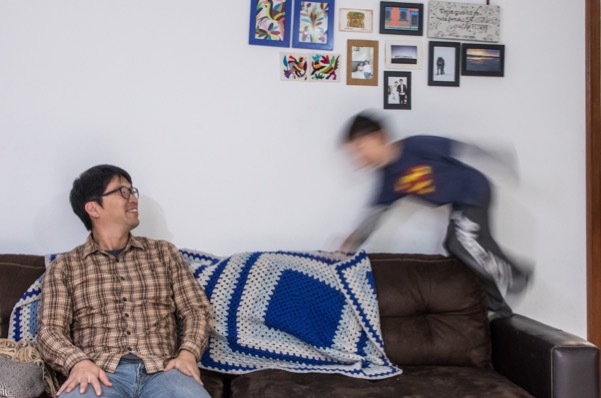
Jae with his son, Sam, who stays on the move. When asked if Jae considers himself an extrovert, Jae smiles as if to say, “Isn’t it obvious?”
Jae strategized. What worked in Korea wouldn’t necessarily work here. He worked closely with the students and drew from what he’d studied of Mexican culture. Today, he even calls himself a Mexican.
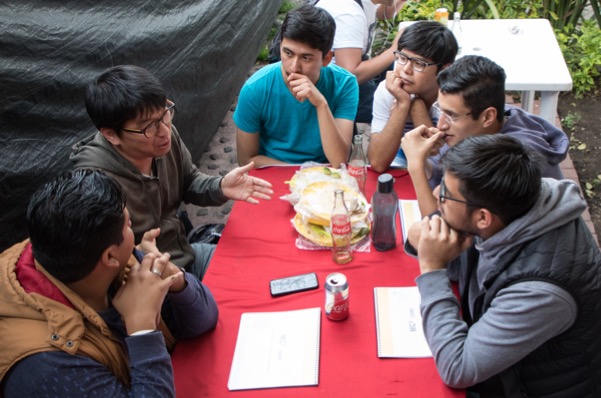
Jae (second from left) meets with Cru® students to plan the upcoming semester over street tacos. Students appreciate Jae providing food at meetings.
Many students came from broken homes or lived far from their families. So Jae mixed a strength of Korean culture—structure—with a strength of Mexican culture—family.
Pairing each Korean with a local Christian, Jae led the team out to gather interested students and have spiritual conversations. To the surprise of local students, friends and strangers wanted to talk about Christ.
One recent graduate, Scarlet Boche, recalls, “Once we approached someone and they said, ‘Yes, I want to accept Christ.’ I remember thinking, Are you sure? Did you get what I said?”
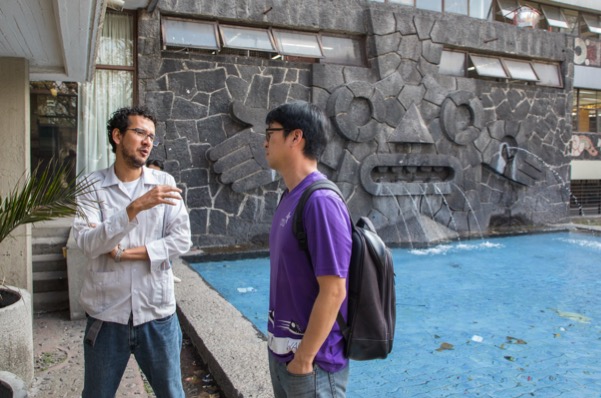
Jae speaks with Julio Diaz, a science professor. Jae purposefully invests time in the lives of UNAM professors.
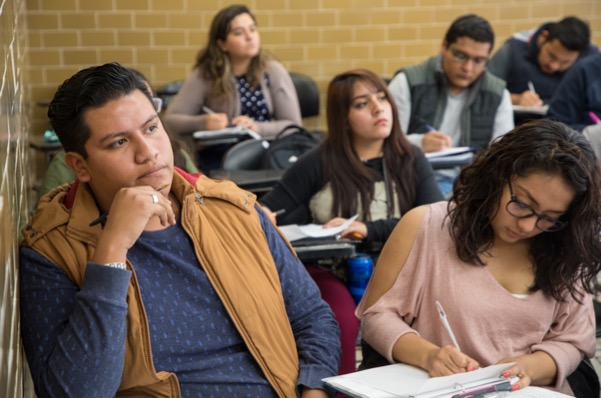
Students often sacrifice to get to UNAM’s campus, many taking a public transit for up to four hours a day.
The Koreans gave special care to those they met, whether in brief conversations or in long-term relationships, and they showed the Mexican students how to avoid spiritual conversation pitfalls. With Jae’s insistence, the Koreans coached the Mexican students with the mindset of growing God’s family.
If they mentored or discipled someone, they called them “son” or “daughter.” If someone disciples them, they’d call them “father” or “mother.” They thought and acted this way, honoring their “father” or “mother” and doing all they could to help their “child” grow in Christ.
In the initial weeks, God provided a house for Cru to meet in and the group grew to 40 people, with 15 student leaders.
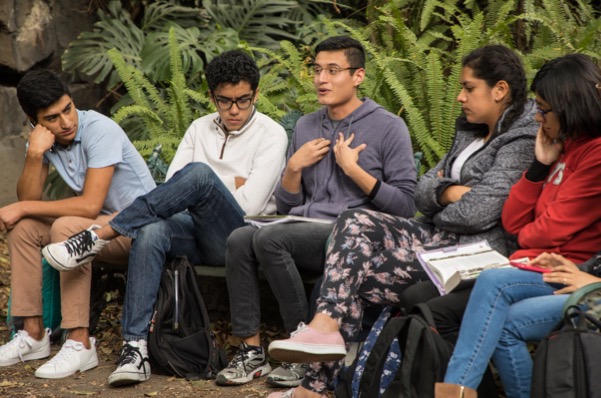
Students gather at one of four concurrent Cru® meetings on UNAM’s campus. Students’ spiritual growth and initiative in ministry at UNAM demonstrate how university students can effectively lead.
A poster on the wall now depicts their discipleship family tree, el árbol genealógico del discipulado. Some students have “grandchildren.” The poster reinforces Jae and Hanna’s vision of a student-led movement.
As the students’ spiritual family grew, Jae and Hanna cooked delicious meals and met with them to train them how to walk with God and how to model that to others. They welcomed the students into their home, inviting them to participate in their lives and the lives of their two young sons. Now, Sam speaks fluent Spanish, and Jae laughs, saying that 2-year-old Nathan is fully Mexican.
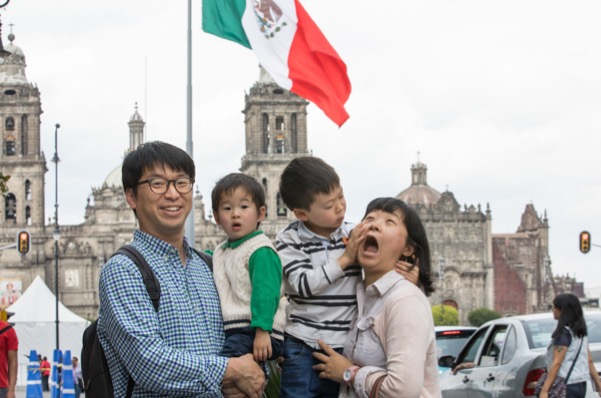
While Jae and his son, Nathan, pose, Jae’s wife, Hanna, good-naturedly wrangles Sam. Behind the family, Mexico city’s Main Square or Constitution Square—and the former center of the Aztec Empire—is bordered by government buildings and the Metropolitan Cathedral.

Sam and Nathan play in Jae and Hanna’s flat. Jae and Hanna juggle hosting students with naptimes, homework, laundry and errands.
Back on campus and an hour before a student-led prayer meeting, Jae sees Josh, walking like he needs another siesta. Jae crosses one of UNAM’s many quads and calls out his nickname for Josh: “Joshi!”
Jae playfully punches Josh and puts his arm around him, trying to wake him up. Josh groans, but he smiles and chuckles from the attention.
Josh tasted the culture shock of doing ministry with the Koreans. As part of Josh’s discipleship, his “father” challenged him to share the gospel 100 times in 100 days. Josh earnestly shared his faith, day after day. But around day 25 he missed a day and lied to his “father” about it.
Distraught, Josh shared his self-described “failure” with his friends. But rather than offer sympathy, they laughed. They knew that Josh’s strict “father” possessed a soft heart. And besides, Josh had shared his faith 25 days in a row.
“Josh was like the Mexican Billy Graham,” says Adiel Maim González Zamora, a friend of Josh.
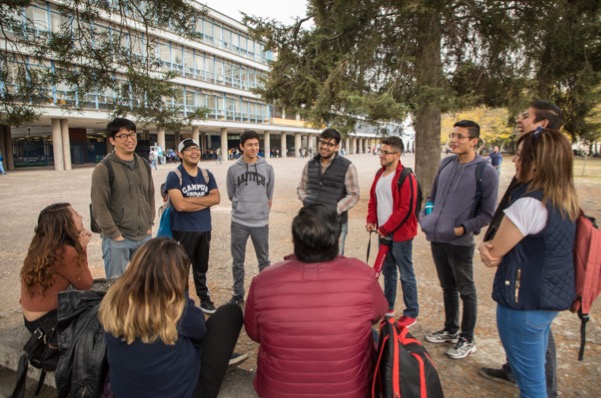
Students meet next to the park, Las Islas, “The Islands,” in front of the building hosting the faculties of law, economics and philosophy.
Today, the spiritual movement continues to spread across UNAM’s campus. Four groups of 20-30 students meet outside on Fridays, then they gather together once a month. A former student, Adaia Sanchez, raised funds and works with the staff team full time. They’re in the process of launching student-led movements on three new campuses in Mexico City.
Josh leads one of the groups at UNAM, teaching the Bill Bright message of having a Christ-centered heart. Later, over street tacos, one of the girls notes the grease all over the Bill Bright book. “It’s definitely the guys’ book,” she smiles.
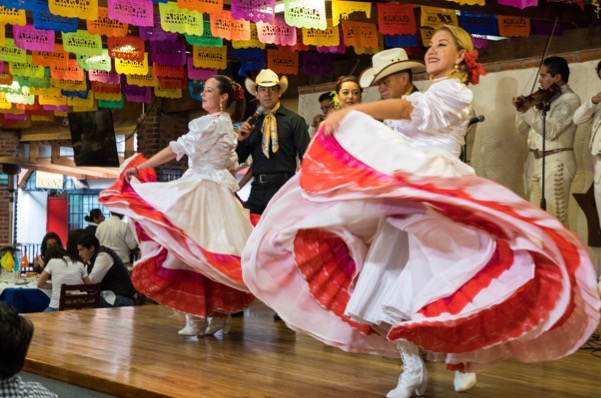
Dancers perform Mexico’s national dance, the Jarabe Tapatío. Mexico City bursts with vibrant colors, music and rich cultural heritage.
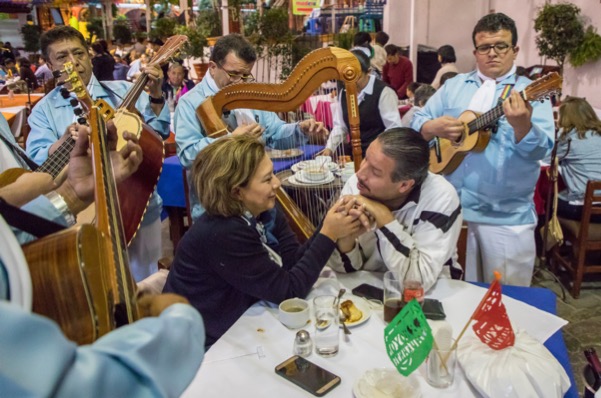
Love, accompanied by Mariachi players, permeates the air in the world’s largest Mexican restaurant, Restaurant Arroyo.
Perhaps grease symbolizes the style of ministry Jae and the students love. If you want to gather students, you should bring food. And make it a fiesta. Jae shakes his head at all the fiestas he’s hosted with Hanna.
“[In ministry] we need to be joyful in Christ,” says Jae, “Sometimes we have a lot of things to do for ministry and with people. Sometimes it’s like work. But it’s not work; it’s not work.”
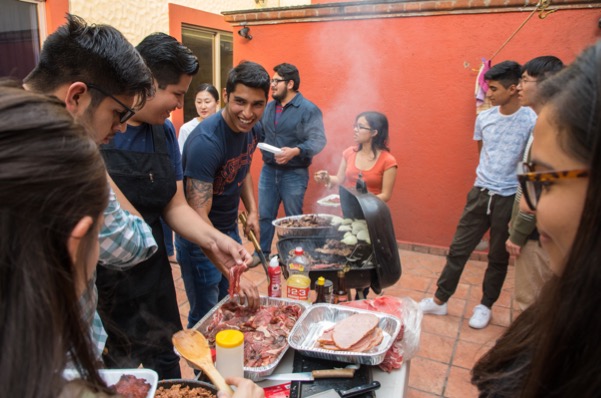
Students grill meat at a farewell fiesta for Mark Bae, a Korean intern with Cru who spent a year at UNAM alongside the Lees.
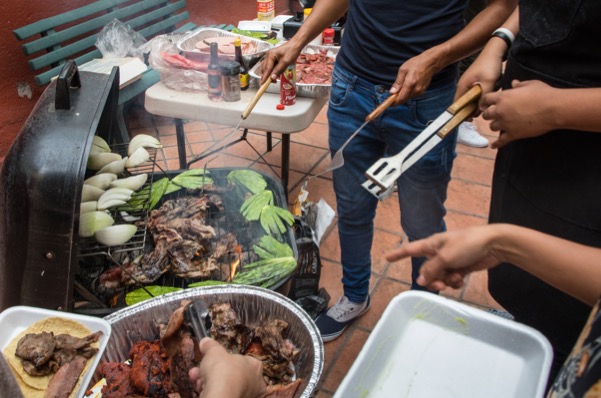
Fiesta guests choose among shredded pork, steak, onions, chicken and cacti to pile on top of a tortilla.
This week, they throw a fiesta to say goodbye to Mark, a Korean man who worked with the ministry for the past year.
At the fiesta, Cru students huddle with newcomers around tables, sipping Coca-Cola made with sugar cane and chewing on pork, chicken or steak gorditas fresh off the grill. Conversation, laughter and savory smells flow through the patio and into the home.
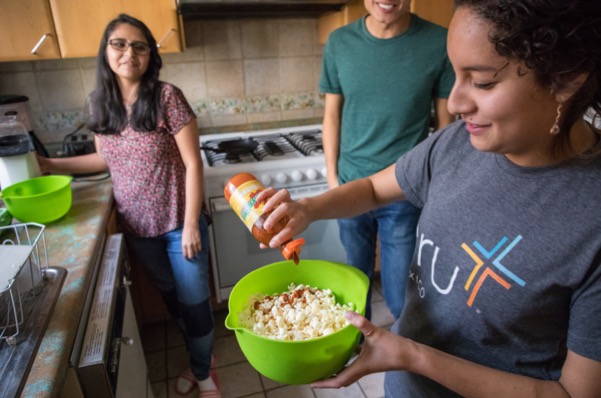
Staff member Evelyn Díaz Gutiérrez, student Alvaro Fernández de Lara Sanchez and volunteer Scarlet Boche (left to right) prepare food for an outreach showing the film A Case for Christ.
As they eat, Mark stands up in the middle of the room to say goodbye.
“I love you, friends, and now we’re family. Thank you for everything we’ve made, everything we’ve shared,” says Mark. “I am thankful, because through you I have learned more about God, about His love and His faithfulness and about the true family.”
One student stands up and asks others to say something about Mark. After he shares, Mark smiles mischievously and says, “Okay, who’s next?”
Josh stands up. “I feel like you’re my best buddy, and I can see God’s love through you,” he says. “And we’ve been through a lot of things. Even happiness and sadness, and you’ve been like a brother to me.”
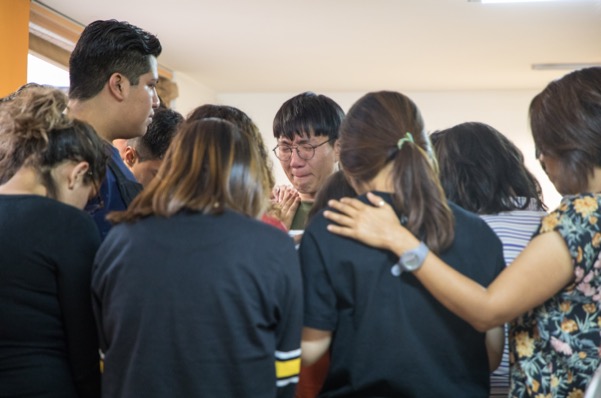
Students circle around Mark, an intern who served with Cru® for more than a year in Mexico City, to pray. Mark worked alongside four other interns from Korea and five full-time staff members, including Jae and Hanna.
As Josh sits, Mark says he wants to hug Josh, to which the room laughs and claps. They know how hard it can be for Koreans to hug.
When the sharing time ends, they all gather around to pray for Mark. Another student jokes that they should pray “Korean style,” where everyone prays out loud at the same time.
The room bursts with color, from more than the bright orange walls. The vibrant color stems from the fellowship in the room, from the strength and power that come from walking through life together. Jae and Hanna know that the family tree poster on the wall will soon branch out.
Refreshed, the students say goodnight and step out onto the cobbled streets of Mexico City, eager to expand el árbol genealógico de Dios, the family tree of God.
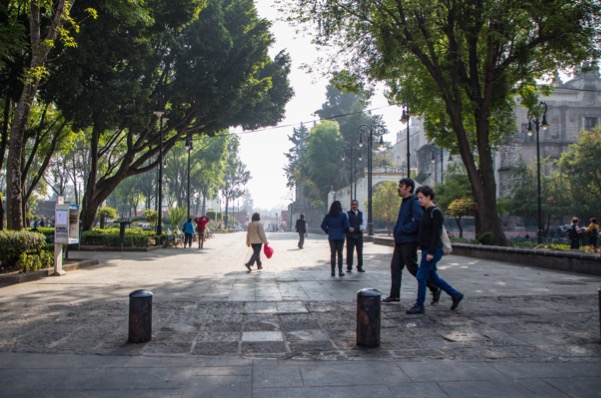
Evening approaches in the streets near artist Frida Kahlo’s blue house, which is now a museum.
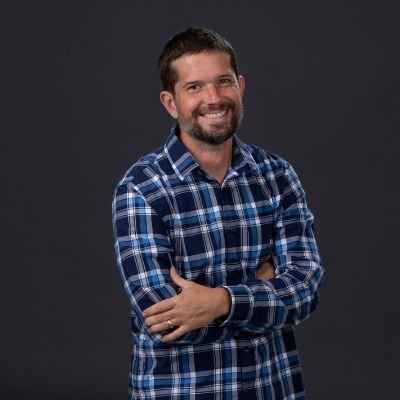
Philip is a soccer coach, freelance writer, and illustrator. He earned a master’s degree in Christian studies at Regent College in Vancouver, British Columbia. Philip balances family life along with bike riding, drawing and whittling toy cars.
Contact Me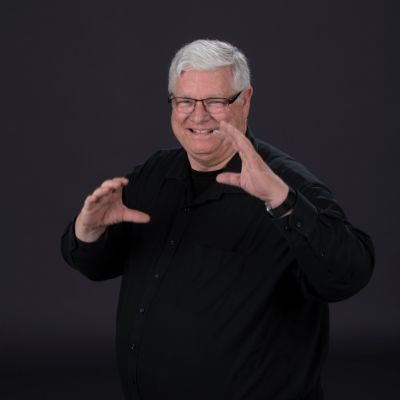
Tom is a photographer with Cru®. He loves seeing beautiful sights out of airplane windows and enjoys meeting new friends all over the world. His wife, Karen, travels with him whenever possible, which makes every trip even better. Tom has been photographing for more than 40 years.
Contact Me